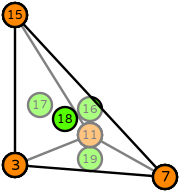Click here to read what the information on this page means.
| Degrees | \(k=3\)
where \(k\) is the polynomial subdegree |
| Polynomial subdegree | \(k\) |
| Polynomial superdegree | \(k\) |
| Reference cells | interval, triangle, tetrahedron |
| Finite dimensional space | \(\mathcal{P}_{k}\)
↓ Show set definitions ↓↑ Hide set definitions ↑\(\mathcal{P}_k=\operatorname{span}\left\{\prod_{i=1}^dx_i^{p_i}\middle|\sum_{i=1}^dp_i\leqslant k\right\}\) |
| DOFs | On each vertex: point evaluations, and point evaluations of derivatives in coordinate directions
On each face: point evaluations at midpoints |
| Number of DOFs | interval: \(4\)
triangle: \(10\)
tetrahedron: \(20\) |
| Mapping | see [2] |
| continuity | Function values are continuous. |
| Notes | The derivatives of the basis functions are continuous between cells at the vertices of the element |
| Categories | Scalar-valued elements |
This element is implemented in
Basix ,
FIAT , and
Symfem .
↓ Show implementation detail ↓↑ Hide implementation detail ↑| Basix | basix.ElementFamily.Hermite
↓ Show Basix examples ↓↑ Hide Basix examples ↑Before running this example, you must install Basix: pip install fenics-basix This element can then be created with the following lines of Python: import basix
# Create Hermite degree 3 on a interval
element = basix.create_element(basix.ElementFamily.Hermite, basix.CellType.interval, 3)
# Create Hermite degree 3 on a triangle
element = basix.create_element(basix.ElementFamily.Hermite, basix.CellType.triangle, 3)
# Create Hermite degree 3 on a tetrahedron
element = basix.create_element(basix.ElementFamily.Hermite, basix.CellType.tetrahedron, 3) |
| FIAT | FIAT.CubicHermite
↓ Show FIAT examples ↓↑ Hide FIAT examples ↑Before running this example, you must install FIAT: pip install firedrake-fiat This element can then be created with the following lines of Python: import FIAT
# Create Hermite degree 3 on a interval
element = FIAT.CubicHermite(FIAT.ufc_cell("interval"), 3)
# Create Hermite degree 3 on a triangle
element = FIAT.CubicHermite(FIAT.ufc_cell("triangle"), 3)
# Create Hermite degree 3 on a tetrahedron
element = FIAT.CubicHermite(FIAT.ufc_cell("tetrahedron"), 3) |
| Symfem | "Hermite"
↓ Show Symfem examples ↓↑ Hide Symfem examples ↑Before running this example, you must install Symfem: pip install symfem This element can then be created with the following lines of Python: import symfem
# Create Hermite degree 3 on a interval
element = symfem.create_element("interval", "Hermite", 3)
# Create Hermite degree 3 on a triangle
element = symfem.create_element("triangle", "Hermite", 3)
# Create Hermite degree 3 on a tetrahedron
element = symfem.create_element("tetrahedron", "Hermite", 3) |
- [1] Ciarlet, Philippe G. and Raviart, Pierre-Arnaud. Interpolation theory over curved elements, with applications to finite element methods, Computer Methods in Applied Mechanics and Engineering 1(2), 217–249, 1972. [DOI: 10.1016/0045-7825(72)90006-0] [BibTeX]
- [2] Kirby, Robert C. A general approach to transforming finite elements, The SMAI journal of computational mathematics 4, 197–224, 2018. [DOI: 10.5802/smai-jcm.33] [BibTeX]
| Element added | 09 January 2021 |
| Element last updated | 20 November 2025 |


